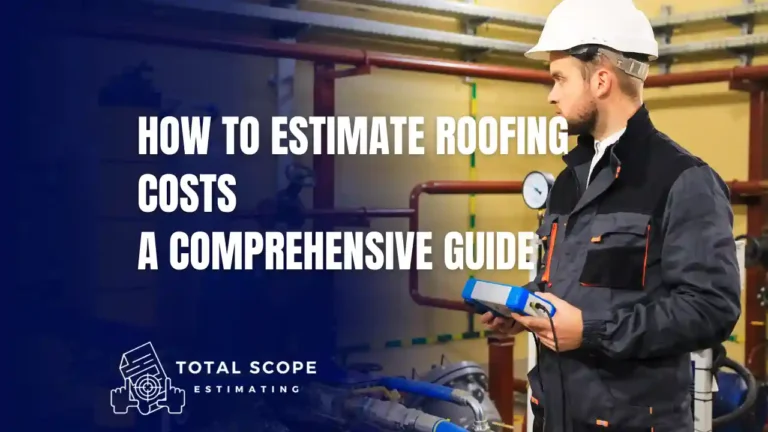Regardless of the nature and scope of the project, it is accomplished when the measurements are done accurately. When discussing construction projects, the quantity takeoff (QTO) is crucial. An accurate quantity takeoff is vital to any construction project, especially in cost estimation. It enables the construction contractors to simplify the project by breaking down the project into several components of cost estimates.
However, knowing the significance of quantity takeoff and how to implement the technology for an accurate takeoff is essential. This article highlights the definition of “What Is Quantity Takeoff In Construction”, types, importance, standard practices, methods, etc.
What Is A Quantity Takeoff?
Quantity Takeoff, also known as material takeoff, refers to analyzing different drawings and models and measuring materials and labor to be used in the construction project.
Quantity takeoffs in construction have many other names, including:
- Estimating takeoffs
- Construction takeoffs
- Earthwork takeoffs
- Material takeoffs
- Material estimating
- Material counts
- Quantity Surveying
- Blueprint Takeoffs
Various companies and contractors use quantity takeoff to improve the budgeting of construction projects. Quantity Takeoff is planned and done in the pre-construction phase of any construction project. The process refers to the breakdown of the construction project into various sections and compartments. It becomes easier to measure and estimate those components to produce a more detailed document for the project costs.
For this purpose, the estimator considers all the drawings, sketches, 3D designs, and blueprints of the construction project. For example, if you are a painting contractor, the QTO will list all the labor and materials along with their quantities and prices. Despite this being important, many people regard QTO as merely the quantification of materials. This article delivers more insight into the definition and the significance of quantity takeoff.
Quantity Takeoff VS Material Takeoff
Table 1: Quantity Takeoff vs. Material Takeoff
| Feature | Quantity Takeoff | Material Takeoff |
| Definition | Detailed measurement of materials and labor. | Broad estimation of materials. |
| Precision | High, uses advanced software. | Moderate, relies on manual methods. |
| Methodology | Involves software and manual verification. | Mainly manual or rough calculations. |
| Applications | Complex projects requiring detailed costing. | Small projects or initial planning phases. |
While both terms overlap and are used interchangeably in different situations, they don’t mean the same. Understanding the gross concept of these terms is essential to ensuring there are no misconceptions in the construction process.
Quantity takeoff technically includes quantifying materials, estimates, and drawings in exact amounts using the latest technology and quantity takeoff software. On the other hand, the material takeoff consists of the materials in gross numbers, which is a rough estimate, you can say.
For construction projects, top-notch digital quantity takeoff is crucial. It removes many complications and is much faster and more precise. It also eliminates much human error, although someone is still required to cross-check for any mistakes.
A manual quantity takeoff consumes more time and strongly depends on skills and knowledge, and any changes can add more time to the construction process. Conversely, a digital takeoff can be repeated with relative speed and convenience.
Why Are Quantity Takeoffs Important In Construction?
As mentioned above, a quantity takeoff precisely measures and lists the materials in quantities. It may seem quite easy, but the reality may be different. In fact, the construction quantity takeoff might be complex, with various tasks and people involved.
Irrespective of the size and span of the project, an accurate and precise construction quantity takeoff is crucial for success. Without accurate construction quantity takeoff, many projects can fall short of success and budget. There are many benefits of quantity takeoffs in construction, which make this process feel so essential for any project. Let’s have an insight into them.
Accurate cost estimating & budgeting
This is undoubtedly the biggest advantage of using quantity takeoffs in construction. A well-planned quantity takeoff provides a strong setting stone for accurate cost estimation and budgets. Having a profound knowledge of what work is required to be done, how much time, and which kind of materials are needed for the project completion, the estimators can predict costs directly from the project documentation. This will assist the estimators in avoiding cost overruns and delivering the project within the given deadline.
Improved communication and trust
It isn’t of any concern if the project is small or big, but the primary concern of any party in any construction project is money and how smartly they can use it to achieve more. Contractors hire estimators for their cost-saving strategies. They are adept in efficient planning and communication.
A quantity takeoff provides essential feedback to keep all the people involved in the construction project informed about all the elements. In this way, transparency of communication is ensured between both parties, leading to effective project management.
Better planning
Apart from the cost estimation and communication, an accurate quantity takeoff also ensures better planning and management of the construction project. It ensures that no information is missed and everything is completed within the suggested time frame to avoid time overruns and delays. This helps the team to streamline their operations, thus enhancing the productivity nad speed of the construction project to be completed.
Win more bids
As the construction industry is evolving, accurate and precise quantity takeoffs give you a plus point over your competitors. The more exact the quantity takeoff is, the more professional and efficient the contractor is, thus leading to the project’s success and winning more bids.
Top Quantity Takeoff Methods
A Quantity Takeoff is a crucial component of any construction project. Any errors and negligence in this stage can significantly impact the overall project cost, budget, timeline, and efficiency. Doing this correctly is pivotal for the smooth operation of the project.
Initially, the estimators did QTO by manually measuring the dimensions and materials. However, as technology advanced, there was more to it. There are two methods for any QTO. They are manual and digital quantity takeoffs.
Manual Quantity Takeoff
This is the traditional and premiere way of quantity takeoff. It refers to the estimation process in which an estimator simply quotes all the drawings, designs, and blueprints of the construction project and measures all the materials and labor required. Then, he lists them comprehensively. They use all equations and calculations to determine each construction project’s exact quantity and item. This information is used for an adequate cost estimate.
While a manual QTO may seem simple, it’s actually much more complicated. It involves using various equations and formulas to ensure the inclusion of all the details. Any errors in this part may lead to underestimating or overestimating the cost estimates.
Digital Quantity Takeoff
The other method of quantity takeoff is digital, which includes using the latest technology and software to quantify the materials. It is the preferred method, leading to a smoother, more effectively planned, swifter, and more accurate cost estimate. Construction software with digital takeoff features streamlines the process and mitigates the risk of human errors.
With a digital QTO, the estimator simply scans the project blueprint into the software to create a higher-quality quantity takeoff. The software then creates a precise list of all the required materials. The estimator can assign error-free and precise formulas to them and run them in the software. In case of any errors or omissions, the estimator can manually correct them.
Manual vs. Digital Quantity Takeoff
| Aspect | Manual QTO | Digital QTO |
| Time Required | Longer | Faster |
| Accuracy | Prone to human error | High precision with error detection. |
| Flexibility | Difficult to update | Easy to modify estimates. |
| Skill Dependency | Requires high expertise | User-friendly software available. |
| Cost Efficiency | May lead to overruns or waste | Reduces overruns and material waste. |
Who Is Involved In Construction Quantity Takeoff?
All the staff involved in the construction project should count for the quantity takeoff process. To begin any construction project, an accurate and precise cost estimate needs to be developed to gain insight into the correct information. Regardless of the size and span of the project, the first step involves calculating the cost of all the required materials.
The essential staff involved in the construction quantity takeoffs comprise architects, contractors, cost estimators, and engineers. Depending on the project type, a project might need more staff to oversee the quantity takeoffs in a project. These include:
- Urban master planners
- Home renovators or residential home builders
- Rail transportation engineers
- Landscapers
- Highway engineers
- Utility contractors
If you are from Texas, please check our Texas service page for more details.
What Measurements Are Required?
When the fabricators manufacture a product, they sell it in the most appropriate way, which is way more feasible and demanding in the market. For example, you don’t purchase a whole box of concrete or bars of iron ores. You can’t measure the paint estimates just like you do the carpet or the doors. So accurate and correct measurements are crucial.
Unit Count
Items like doors, windows, bars, nails, pipe fittings, hinges, and power points need to be included in the unit count. For items like nails and hinges, one unit consists of 500 units, while some items need to be purchased individually, like air conditioners, generators, etc. Occasionally, the same item comes in diverse sizes. So, you need to have accurate measurements to customize the items to your requirements and specifications.
Linear Length
Although some items like pipe fittings, iron bars, electrical wiring, and steel pieces can be counted on, they are sold in the market according to their lengths. So, you need to measure them accurately.
Surface Area
For the material that is required to cover up the space, like carpet and concrete roofs, an exact calculation of all dimensions is needed. This is done by multiplying their lengths with the widths. This is useful while taking roof takeoff quantities.
Cubic Volume
When filling space, such as with concrete or blow-in insulation, the measurements needed are accomplished by multiplying the length, width, and height of the dimensions. This calculation will lead to the cubic volume of the material, allowing you to calculate its cost estimation precisely.
Physical Weight
Materials like sand or backfill are measured according to their weights, such as a ton of sand. They are generally bought in a standard amount, and an overestimation is required to ensure the procurement of an ample quantity of the material in case of material wastage and spillage.
Looking for estimation services in California? Currently we offer upto 35% discount on our all services. Check out here.
What Isn’t Included In Quantity Takeoff?
To avoid any mistakes and errors in the cost estimate, it needs to be done accurately. The estimator needs to have a profound knowledge of the inclusion and exclusion of all materials. He should be aware of which materials tend not to be included in the cost estimate. Some of the material which is not included in the quantity takeoffs are:
- Transportation costs
- Loading and unloading costs
- Scaffolding
- Lapping and waste materials
- Stripping formwork
How To Do A Quantity Takeoff – The Basics
Preparing a quantity takeoff involves converting the project blueprints and designs into data points and using that information to streamline the project. It begins with counting the required materials and listing them to reach a final cost estimate. That cost estimate is later on used to create a quotation or prepare a budget estimate for the construction project. For this purpose, it is essential to understand which materials are required and how to quantify them.

Understand what needs to be counted.
The first step is to understand the construction project. The construction cost estimators should thoroughly review all the bid documents, including project designs, engineering plans, and contracts. The person in charge of the takeoff process may not necessarily be in charge of the project’s requirements. That’s why the estimators should count every item present in boxes and list them. For example, one reverse-cycle air conditioner, three boxes of roofing nails, or 12 silver doorknobs.
Divide the work into sections.
This practice is most useful in the case of huge and complex construction projects. This involves a breakdown of the construction project into various sections and compartments that are easy to manage. For example, some construction projects may be divided into floors or, in the case of complex projects, by buildings.
But this process doesn’t stop here. After the broad grouping, they are further categorized into assemblies. Assemblies are smaller components of the project. For example, while measuring the perimeter wall, the contractor needs to measure diverse materials like concrete, bricks, etc., which need to be assembled beforehand.
Take measurements
It is the same for materials that are bought by length, weight, area, or volume; they need to be measured and priced, and the calculation added to the material takeoff list.
Calculate the takeoff
Once the material takeoff is completed, it’s time to convert those amounts and quantities into a dollar amount. It includes the cost per length, cost per weight, cost per number, and the contractors’ charges. However, it’s essential to balance the costs and the quality so it doesn’t cause any delays or cost overruns in the future.
Top 5 Features Of Construction Quantity Takeoff
Estimation software allows estimators to create up-to-date measurements of the materials and labor needed for the completion of the construction project, enabling effective risk management, enhanced productivity, and the creation of attractive bids. Therefore, the selection of the right construction quantity takeoff software is important. The following are some essential features that need to be considered while choosing the takeoff software in construction:
Takeoff Templates
The most effective way to maintain cost estimates is to use takeoff templates to streamline the process. This is especially important for those items and quantities that require to be updated on a routine basis. Those templates are easy to use for the entry of data points and are susceptible to personalization.
Quantity Tracking
Quantities can be separated into the various stages of the contract by categorizing them into Bill, Final, Claimed, and Actual Quantities. By comparing these amounts at the end of the project process, you’ll better comprehend the difference between projected versus actual costs. This leads to effective planning for future tenders, increasing the chances of winning them.
Document Support
Waiting for documents to be ready or accessible is a huge waste of time. That’s why the software you decide to invest in must allow for ready access to drawings and blueprints with minimal memory usage, irrespective of the user’s computer hardware.
Conclusion
As this post has indicated, quantity takeoff is a fundamental process for accurate cost estimation in any construction project. There are two different quantity takeoff methods for creating estimates. However, as the world has advanced, digital processes are quickly taking over. They are much more popular these days because of their effective benefits, such as reduction of errors and wastage and increasing accuracy and efficiency. Hope all your queries regarding What Is Quantity Takeoff, are solved. If you still have any question or want to share your opinion, you can comment here.





